flat tire TOYOTA PRIUS PHV 2012 Owner's Guide
[x] Cancel search | Manufacturer: TOYOTA, Model Year: 2012, Model line: PRIUS PHV, Model: TOYOTA PRIUS PHV 2012Pages: 684, PDF Size: 12.16 MB
Page 544 of 684

544 5-2. Steps to take in an emergency
PRIUS PHV_OM_OM47818U_(U)
CAUTION
As an added safety feature, your vehicle has been equipped with a tire
pressure monitoring system (TPMS-ti re pressure warning system) that
illuminates a low tire pressure telltal e (tire pressure warning light) when
one or more of your tires is significantly under-inflated. Accordingly,
when the low tire pressu re telltale (tire pressure warning light) illumi-
nates, you should stop and check your tires as soon as possible, and
inflate them to the proper pressure. Driving on a significantly under-
inflated tire causes the tire to overheat and can lead to tire failure.
Under-inflation also reduces fuel effi ciency and tire tread life, and may
affect the vehicle’s handling and stopping ability.
Please note that the TPMS (tire pressure warning system) is not a sub-
stitute for proper tire main tenance, and it is the driver’s responsibility to
maintain correct tire pressure, even if under-inflation has not reached the
level to trigger illu mination of the TPMS low tire pressure telltale (tire
pressure warning light).
Your vehicle has also been equipped with a TPMS (tire pressure warning
system) malfunction indicator to indi cate when the system is not operat-
ing properly. The TPMS (tire pressure warning system) malfunction indi-
cator is combined with the low tire pressure telltale (tire pressure
warning light). When the system det ects a malfunction, the telltale will
flash for approximately one minute an d then remain continuously illumi-
nated. This sequence will continue upon subsequent vehicle start-ups as
long as the malfunction exists. When the malfunction indi cator is illumi-
nated, the system may not be able to detect or signal low tire pressure
as intended.
Page 566 of 684
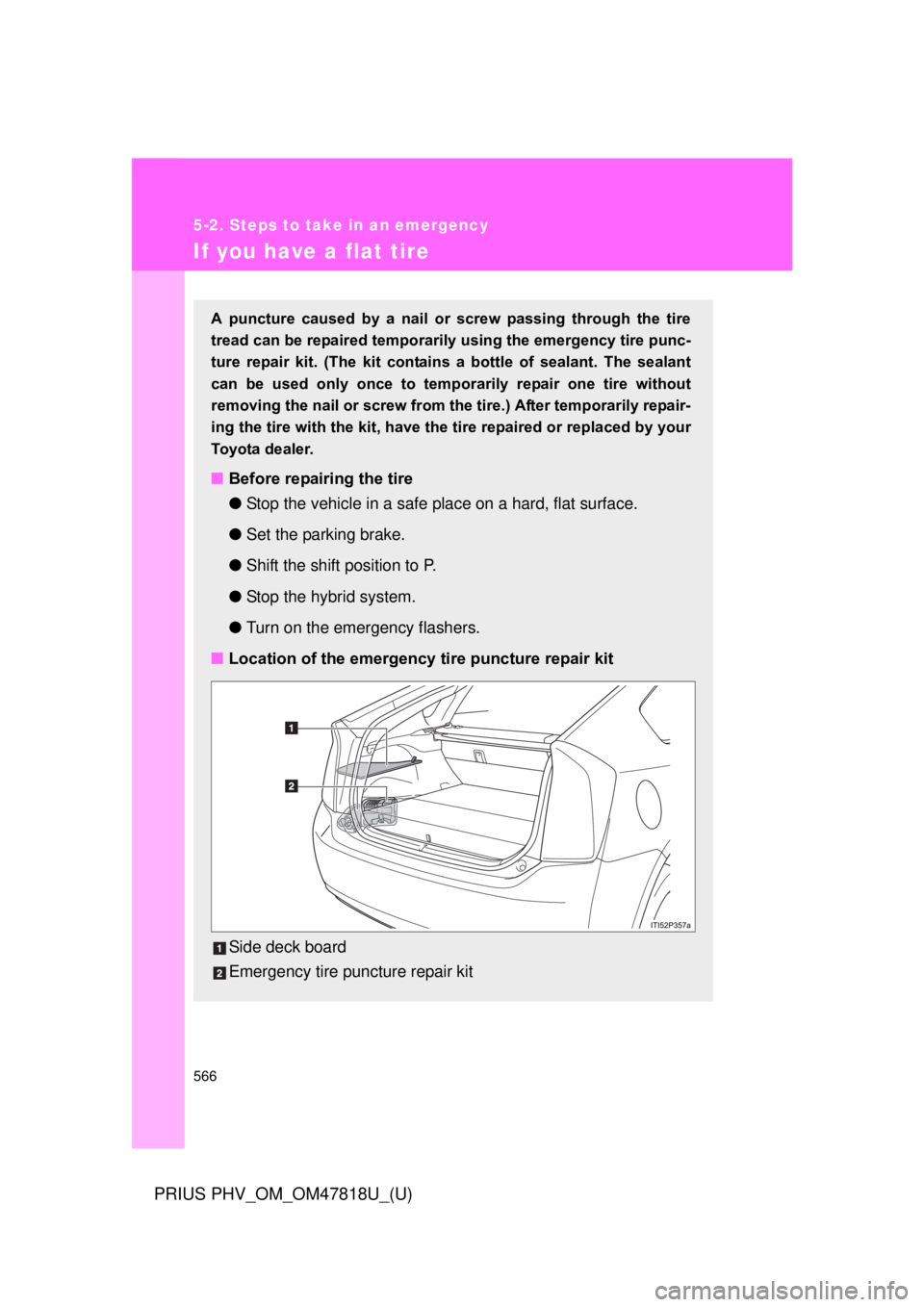
566
5-2. Steps to take in an emergency
PRIUS PHV_OM_OM47818U_(U)
If you have a flat tire
A puncture caused by a nail or screw passing through the tire
tread can be repaired temporarily using the emergency tire punc-
ture repair kit. (The kit contains a bottle of sealant. The sealant
can be used only once to temporarily repair one tire without
removing the nail or screw from the tire.) After temporarily repair-
ing the tire with the kit, have the tire repaired or replaced by your
Toyota dealer.
■ Before repairing the tire
●Stop the vehicle in a safe pl ace on a hard, flat surface.
● Set the parking brake.
● Shift the shift position to P.
● Stop the hybrid system.
● Turn on the emergency flashers.
■ Location of the emergency tire puncture repair kit
Side deck board
Emergency tire puncture repair kit
Page 576 of 684
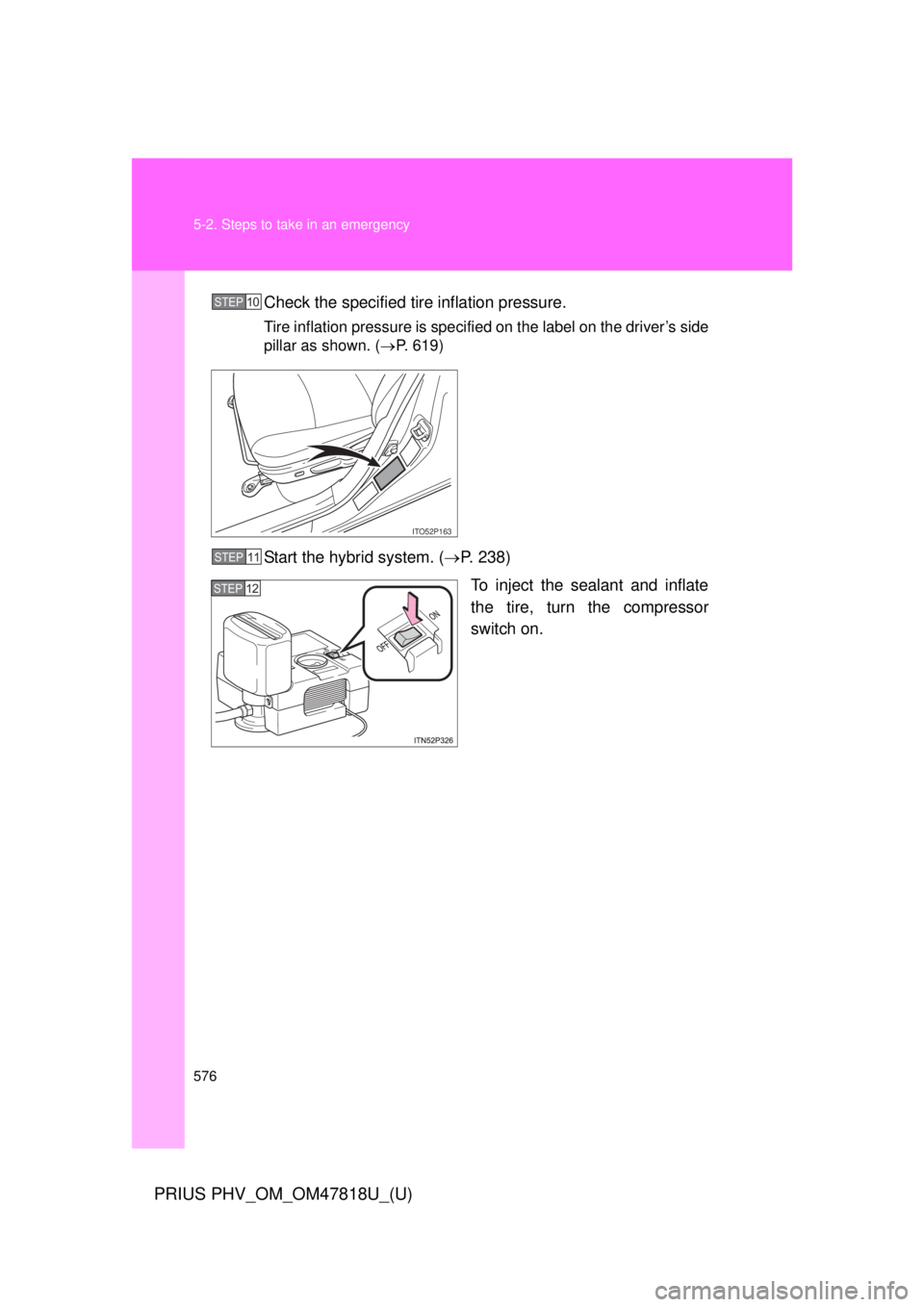
576 5-2. Steps to take in an emergency
PRIUS PHV_OM_OM47818U_(U)
Check the specified tire inflation pressure.
Tire inflation pressure is specified on the label on the driver’s side
pillar as shown. ( P. 619)
Start the hybrid system. ( P. 238)
To inject the sealant and inflate
the tire, turn the compressor
switch on.
STEP10
ITO52P163
STEP11
STEP12
Page 577 of 684
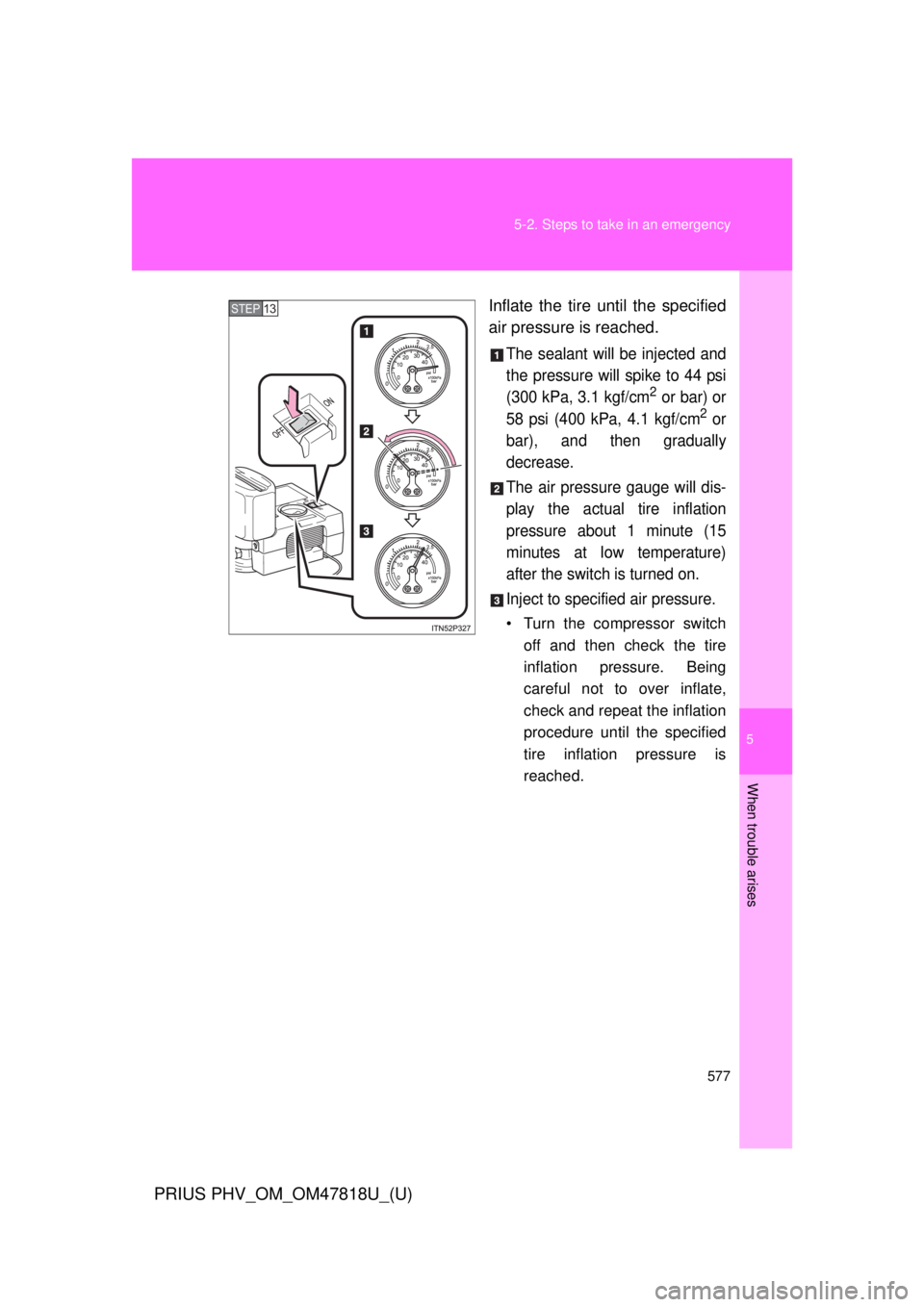
5
When trouble arises
577
5-2. Steps to take in an emergency
PRIUS PHV_OM_OM47818U_(U)
Inflate the tire until the specified
air pressure is reached.
The sealant will be injected and
the pressure will spike to 44 psi
(300 kPa, 3.1 kgf/cm
2 or bar) or
58 psi (400 kPa, 4.1 kgf/cm2 or
bar), and then gradually
decrease.
The air pressure gauge will dis-
play the actual tire inflation
pressure about 1 minute (15
minutes at low temperature)
after the switch is turned on.
Inject to specified air pressure.
• Turn the compressor switch
off and then check the tire
inflation pressure. Being
careful not to over inflate,
check and repeat the inflation
procedure until the specified
tire inflation pressure is
reached.
STEP13
Page 578 of 684

578 5-2. Steps to take in an emergency
PRIUS PHV_OM_OM47818U_(U)
• If the tire inflation pressure isstill lower than the specified
point after inflation for 10
minutes (40 minutes at low
temperature) with the switch
on, the tire is too damaged to
be repaired. Turn the com-
pressor switch off and con-
tact your Toyota dealer.
• If the tire inflation pressure exceeds the specified air
pressure, let out some air to
adjust the tire inflation pres-
sure. ( P. 582, 619)
With the compressor switch off, disconnect the hose from the
valve on the tire and then pull out the power plug from the
power outlet socket.
Some sealant may leak when the hose is removed.
Install the valve cap onto the valve of the emergency repaired
tire.
STEP14
STEP15
Page 579 of 684
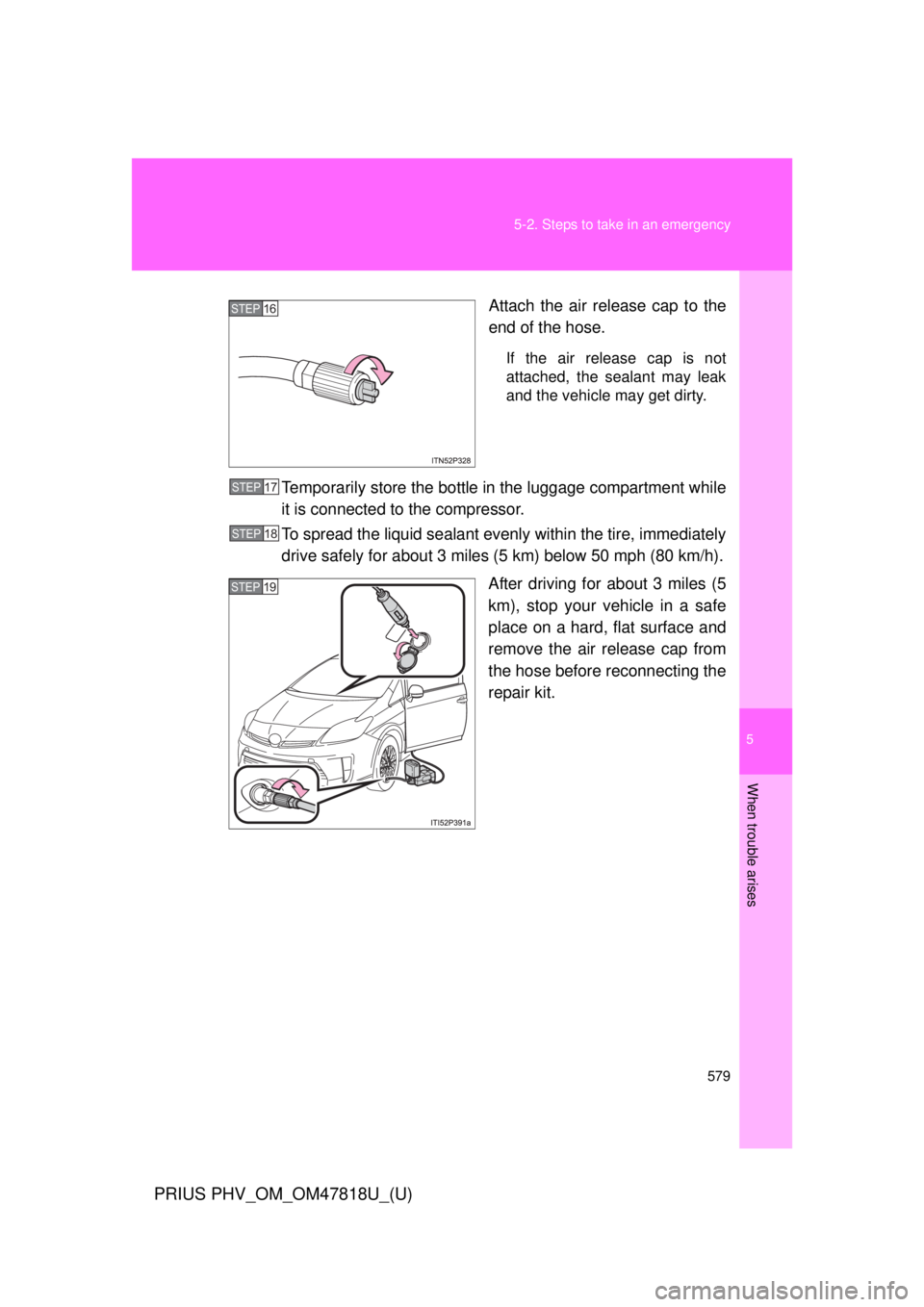
5
When trouble arises
579
5-2. Steps to take in an emergency
PRIUS PHV_OM_OM47818U_(U)
Attach the air release cap to the
end of the hose.
If the air release cap is not
attached, the sealant may leak
and the vehicle may get dirty.
Temporarily store the bottle in the luggage compartment while
it is connected to the compressor.
To spread the liquid sealant evenl
y within the tire, immediately
drive safely for about 3 miles (5 km) below 50 mph (80 km/h).
After driving for about 3 miles (5
km), stop your vehicle in a safe
place on a hard, flat surface and
remove the air release cap from
the hose before reconnecting the
repair kit.
STEP16
STEP17
STEP18
STEP19
Page 580 of 684
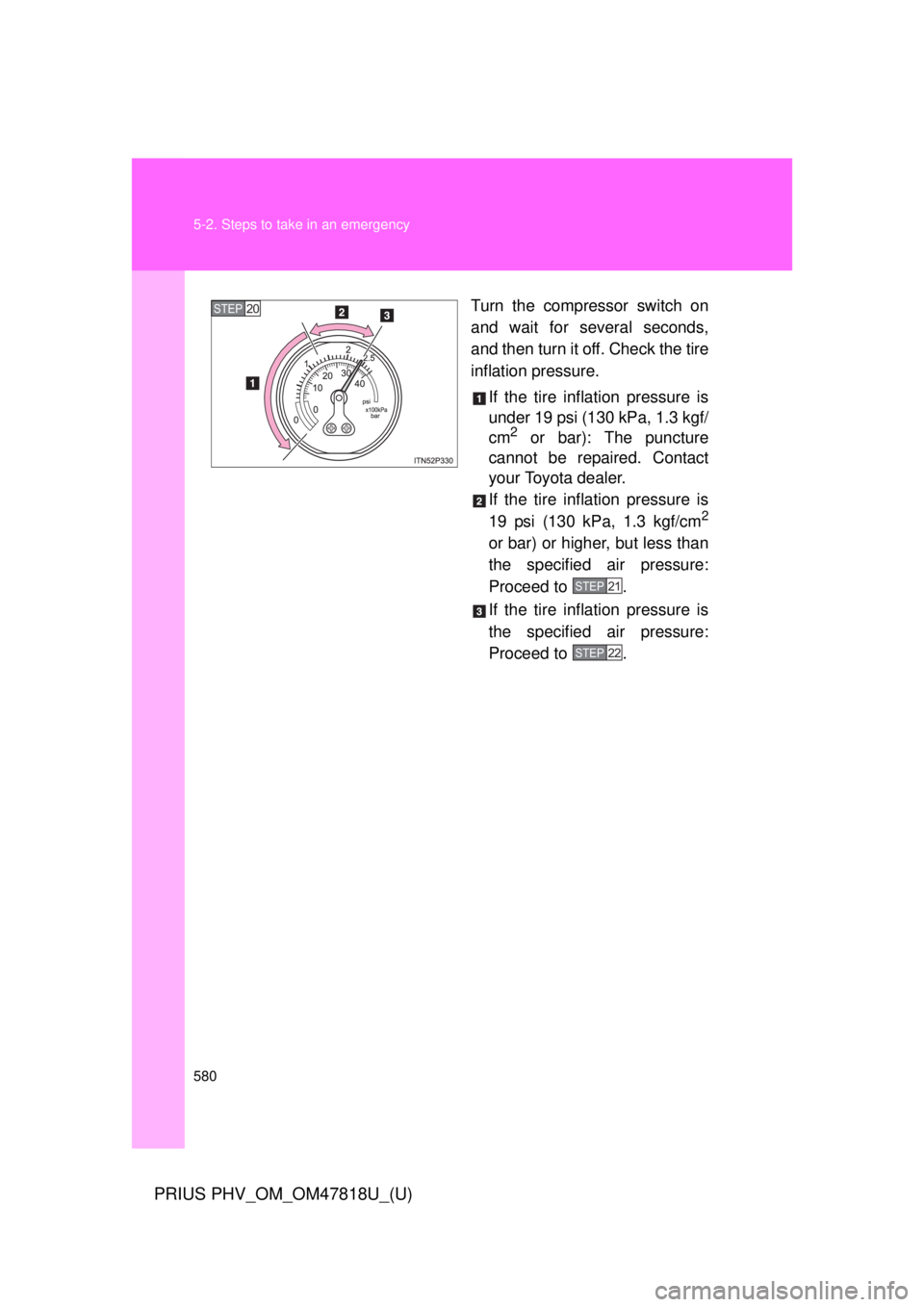
580 5-2. Steps to take in an emergency
PRIUS PHV_OM_OM47818U_(U)
Turn the compressor switch on
and wait for several seconds,
and then turn it off. Check the tire
inflation pressure.If the tire inflation pressure is
under 19 psi (130 kPa, 1.3 kgf/
cm
2 or bar): The puncture
cannot be repaired. Contact
your Toyota dealer.
If the tire inflation pressure is
19 psi (130 kPa, 1.3 kgf/cm
2
or bar) or higher, but less than
the specified air pressure:
Proceed to .
If the tire inflation pressure is
the specified air pressure:
Proceed to .
STEP20
STEP21
STEP22
Page 581 of 684
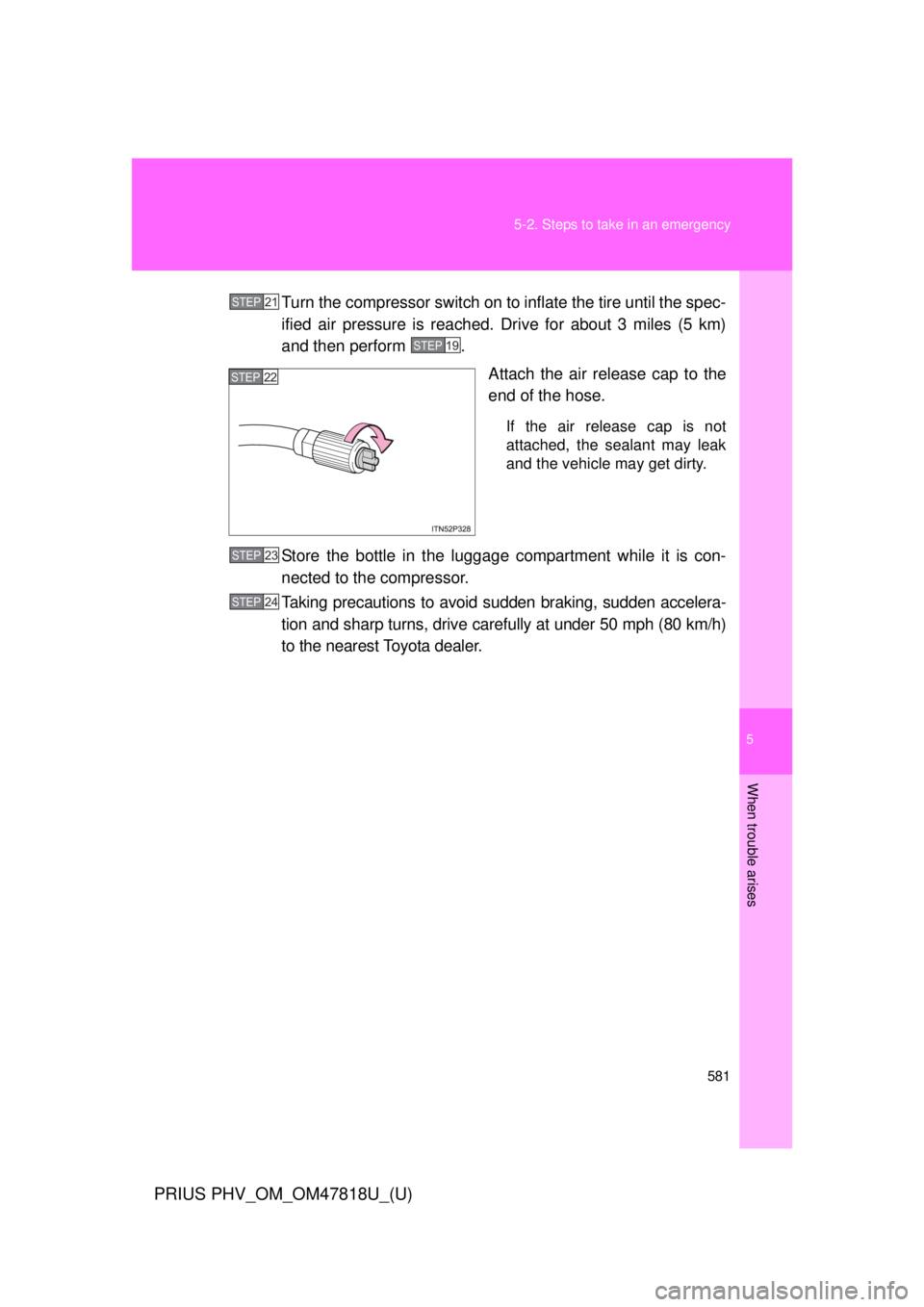
5
When trouble arises
581
5-2. Steps to take in an emergency
PRIUS PHV_OM_OM47818U_(U)
Turn the compressor switch on to inflate the tire until the spec-
ified air pressure is reached. Drive for about 3 miles (5 km)
and then perform .
Attach the air release cap to the
end of the hose.
If the air release cap is not
attached, the sealant may leak
and the vehicle may get dirty.
Store the bottle in the luggage compartment while it is con-
nected to the compressor.
Taking precautions to avoid sudden braking, sudden accelera-
tion and sharp turns, drive carefully at under 50 mph (80 km/h)
to the nearest Toyota dealer.
STEP21
STEP19
STEP22
STEP23
STEP24
Page 582 of 684
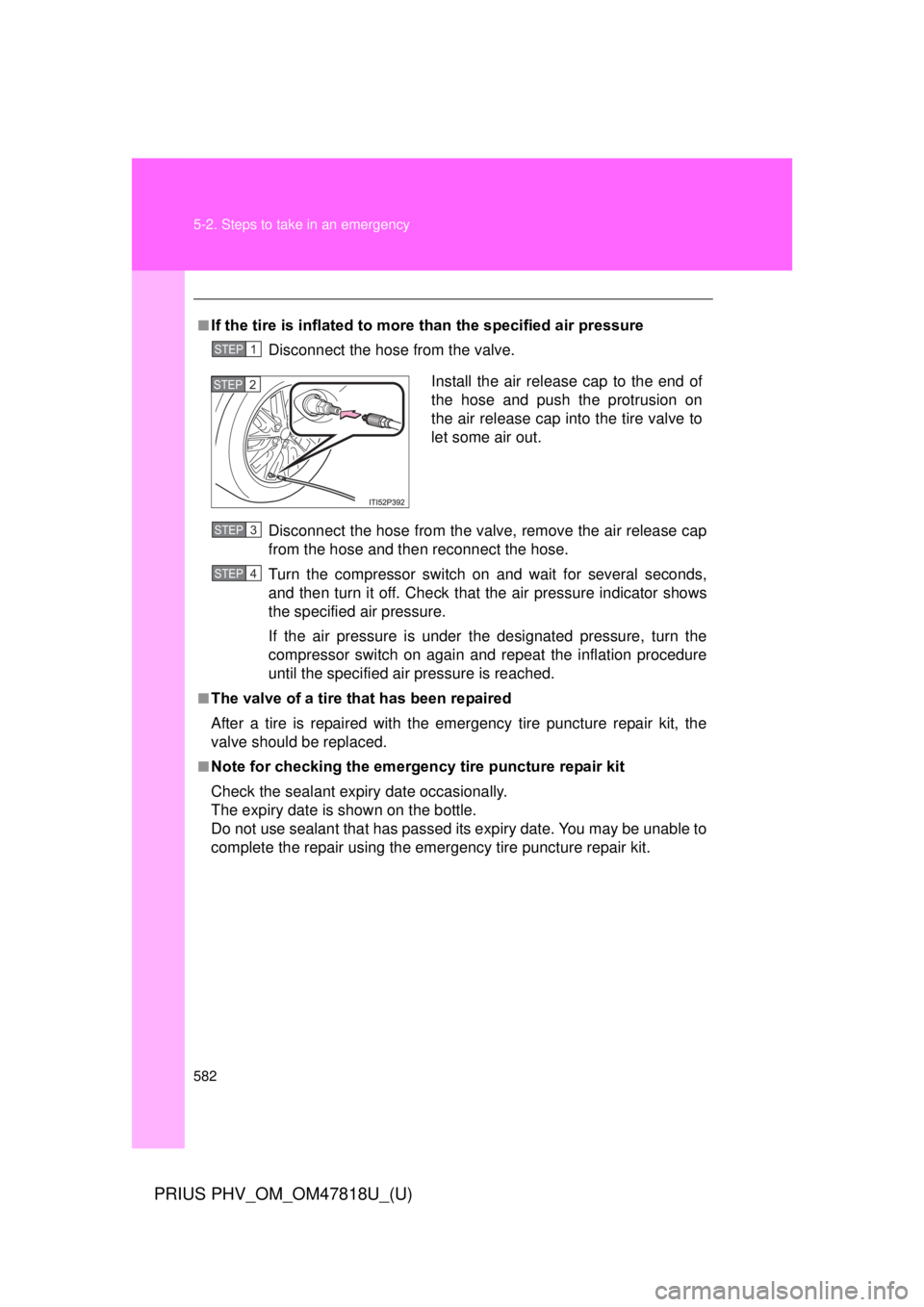
582 5-2. Steps to take in an emergency
PRIUS PHV_OM_OM47818U_(U)
■If the tire is inflated to more than the specified air pressureDisconnect the hose from the valve.
Disconnect the hose from the valve, remove the air release cap
from the hose and then reconnect the hose.
Turn the compressor switch on and wait for several seconds,
and then turn it off. Check that the air pressure indicator shows
the specified air pressure.
If the air pressure is under the designated pressure, turn the
compressor switch on again and repeat the inflation procedure
until the specified air pressure is reached.
■The valve of a tire that has been repaired
After a tire is repaired with the emergency tire puncture repair kit, the
valve should be replaced.
■Note for checking the emergency tire puncture repair kit
Check the sealant expiry date occasionally.
The expiry date is shown on the bottle.
Do not use sealant that has passed it s expiry date. You may be unable to
complete the repair using the emergency tire puncture repair kit.
STEP 1
Install the air release cap to the end of
the hose and push the protrusion on
the air release cap into the tire valve to
let some air out.STEP 2
STEP 3
STEP 4
Page 584 of 684

584 5-2. Steps to take in an emergency
PRIUS PHV_OM_OM47818U_(U)
CAUTION
■Do not drive the vehicle with a flat tire
Do not continue driving with a flat tire.
Driving even a short distance with a flat tire can damage the tire and the
wheel beyond repair.
Driving with a flat tire may cause a circumferential groove on the side
wall. In such a case, the tire may explode when using a repair kit.
■Caution while driving
●Store the repair kit in the luggage compartment.
Injuries may result in the event of an accident or sudden braking.
●The repair kit is exclusively only for your vehicle.
Do not use repair kit on other vehicles, which could lead to an accident
causing death or serious injury.
●Do not use repair kit for tires that are different size than the original
ones, or for any other purpose. If the tires have not been completely
repaired, it could lead to an accident causing death or serious injury.
■Precautions for use of the sealant
●Ingesting the sealant is hazardous to your health. If you ingest sealant,
consume as much water as possible, and then immediately consult a
doctor.
●If sealant gets in eyes or adheres to skin, immediately wash it off with
water. If discomfort persists, consult a doctor.